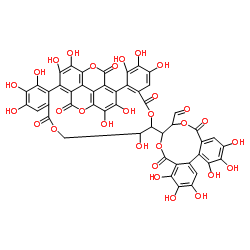Punicalagin

Punicalagin structure
|
Common Name | Punicalagin | ||
|---|---|---|---|---|
| CAS Number | 65995-63-3 | Molecular Weight | 1084.718 | |
| Density | 2.1±0.1 g/cm3 | Boiling Point | N/A | |
| Molecular Formula | C48H28O30 | Melting Point | N/A | |
| MSDS | Chinese USA | Flash Point | N/A | |
|
Effects of pomegranate chemical constituents/intestinal microbial metabolites on CYP1B1 in 22Rv1 prostate cancer cells.
J. Agric. Food Chem. 57(22) , 10636-44, (2009) The cytochrome P450 enzyme, CYP1B1, is an established target in prostate cancer chemoprevention. Compounds inhibiting CYP1B1 activity are contemplated to exert beneficial effects at three stages of prostate cancer development, that is, initiation, progression... |
|
|
Biological activities of phenolic compounds isolated from galls of Terminalia chebula Retz. (Combretaceae).
Nat. Prod. Res. 24(20) , 1915-26, (2010) The aqueous extract of galls from Terminalia chebula Retz. (Combretaceae) was fractionated on Diaion and refractionated on octadecyl silica column. Six phenolic compounds were isolated and identified as gallic acid (1), punicalagin (2), isoterchebulin (3), 1,... |
|
|
Inhibition of melanin content by Punicalagins in the super fruit pomegranate (Punica granatum).
J. Cosmet. Sci. 64(6) , 445-53, (2013) Current efforts to develop effective skin lightening products through the inhibition of melanin production have focused on compounds that inhibit the function and activity of tyrosinase, the rate-limiting enzyme in the melanin biosynthesis pathway. Synthetic ... |
|
|
Pomegranate polyphenols and extract inhibit nuclear factor of activated T-cell activity and microglial activation in vitro and in a transgenic mouse model of Alzheimer disease.
J. Nutr. 143(5) , 597-605, (2013) Alzheimer disease (AD) brain is characterized by extracellular plaques of amyloid β (Aβ) peptide with reactive microglia. This study aimed to determine whether a dietary intervention could attenuate microgliosis. Memory was assessed in 12-mo-old male amyloid ... |
|
|
Changes on indigenous microbiota, colour, bioactive compounds and antioxidant activity of pasteurised pomegranate juice.
Food Chem. 141(3) , 2122-9, (2013) Juices prepared from arils of 'Mollar' pomegranates were analysed for naturally occurring microorganisms, CIE Lab colour parameters, total phenols, anthocyanins and punicalagins, ellagic acid content and antioxidant capacity before and after low-, mild- and h... |
|
|
Inhibitory effects of polyphenol punicalagin on type-II collagen degradation in vitro and inflammation in vivo.
Chem. Biol. Interact. 205(2) , 90-9, (2013) Cartilage destruction is a crucial process in arthritis and is characterized by the degradation of cartilage proteins, proteoglycans, and type II collagen (CII), which are embedded within the extracellular matrix. While proteoglycan loss can be reversed, the ... |
|
|
[Addition of pomegranate juice to statin inhibits cholesterol accumulation in macrophages: protective role for the phytosterol beta-sitosterol and for the polyphenolic antioxidant punicalagin].
Harefuah 152(9) , 513-5, 565, (2013) Macrophage cholesterol and oxidized lipids accumulation and foam cell formation occur in the early stages of atherosclerosis development. In the current study we used the J774A.1 murine macrophage cell line in order to analyze two atherogenic functions: a. th... |
|
|
Pomegranate phytosterol (β-sitosterol) and polyphenolic antioxidant (punicalagin) addition to statin, significantly protected against macrophage foam cells formation.
Atherosclerosis 226(1) , 110-7, (2013) To assess the anti-atherogenic effects on macrophage cholesterol biosynthesis rate, and on cellular oxidative stress by the combination of simvastatin with a potent polyphenolic antioxidant (punicalagin), or with a phytosterol (β-sitosterol), or with pomegran... |
|
|
Inhibition of melanin production by a combination of Siberian larch and pomegranate fruit extracts.
Fitoterapia 83(6) , 989-95, (2012) In an effort to find botanicals containing polyphenolic compounds with the capacity to inhibit melanin biosynthesis, we identified a novel combination of Siberian larch (Larix sibirica) extract, standardized to 80% taxifolin, and pomegranate fruit (Punica gra... |
|
|
Hydrolyzable tannins (chebulagic acid and punicalagin) target viral glycoprotein-glycosaminoglycan interactions to inhibit herpes simplex virus 1 entry and cell-to-cell spread.
J. Virol. 85(9) , 4386-98, (2011) Herpes simplex virus 1 (HSV-1) is a common human pathogen that causes lifelong latent infection of sensory neurons. Non-nucleoside inhibitors that can limit HSV-1 recurrence are particularly useful in treating immunocompromised individuals or cases of emergin... |